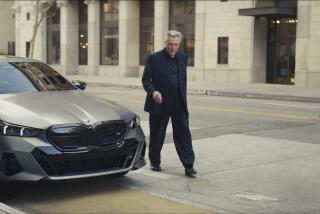RATING CAR ADS : Mercedes Led Pack in Research Firm’s Television Analysis
- Share via
The worst was Nissan. Next to worst, however, was a tie between Chrysler and Dodge. The best was Mercedes-Benz--followed closely by Volkswagen and Subaru.
What we’re talking about here aren’t cars--but television commercials for them. And after studying 100 national car advertisements for the 1988 model year, the Los Angeles advertising research firm Phase One Advertising Analysis has selected the best--and worst--automobile advertisements for the 1988 model year.
“A lot of advertising agencies are probably not very thrilled with our results,” said Loy Baxter, chairman of Phase One. “But we look for basic things in auto ads--like do they capture and hold attention, and do they explain the benefits of the cars?”
So far, commercials created for Nissan, Chrysler and Dodge models were farthest off the mark in 1988, according to the just-completed Phase One study. In most cases, the company found, the worst ads were simply too confusing. At the same time, the best ads were credited with getting across clear messages--and the messages were central to the cars themselves.
“Nissan comes out worst,” said Jim Hillson, senior analyst at the 17-year-old research firm. “The ideas for the ads were very well founded--that Nissan builds cars differently from everyone else--but the ads completely failed to deliver on that promise.”
In particular, he said, the commercials that featured engineers seated at a table discussing “human engineering,” were very confusing. “This was the biggest missed opportunity of the year,” said Hillson. “The idea is well founded, but the commercial is so cluttered that there is absolutely no focus to it.”
Liked by Young
The ad was created by the Los Angeles ad firm Chiat/Day, which will soon complete filming of brand-new commercials for Nissan’s 1989 model cars. For its part, Nissan says it is still pleased with the ad agency and its efforts. “If you were to ask us, would we do the same campaign over again, my answer would be absolutely yes,” said Terry Foutz, Nissan’s national car advertising manager.
Nissan’s own research revealed that while some people over 50 years old were troubled by the recent ad campaign, most younger viewers liked it. “From our point of view, it was a successful ad campaign,” said Foutz.
Phase One, instead of studying completed commercials, usually is retained by clients to review ads in the so-called story board stage--where ideas for ads are illustrated by artists on paper. It then offers a critique based on an ad’s content. The company has six analysts whose sole job is to study commercials. Phase One Chairman Baxter spent 30 years with the ad firm J. Walter Thompson and is a former senior vice president and general manager of Thompson’s western region.
Exactly how did Phase One determine which commercials were worst and best? Well, the company does not interview consumers for opinions on ads. Instead, the research firm has six analysts who review all advertisements. These analysts ask and answer an average 8,484 questions about the content and structure of each commercial--then draw conclusions from these answers. Because the company’s clients include Toyota and the Chevrolet division of General Motors, commercials for these two car makers were excluded from the final results of the study.
But the importance of testing the effectiveness of car ads has never been more clear. Last year, auto makers spent more than $3.3 billion on advertising in the United States, according to the New York research firm BAR/LNA Multi Media Services. And with some 160 car models on the market--and those numbers expected to surpass 200 by 1990--the competition is fierce.
“As cars continue to become more and more alike, one of the only ways left to differentiate one from the other is through image advertising,” said Hillson. “And this is basically the last chance for car makers to position their cars for the 1990s.”
In that case, Chrysler might want to take a second look at some of its ads for the New Yorker--as well as one of the Dodge division’s ads for Dodge Shadow.
A recent Chrysler New Yorker commercial--featuring actor Ricardo Montalban--is a hodgepodge of information with no real focus, said Hillson. The 60-second commercial, created by the New York ad firm Bozell, Jacobs, Kenyon & Eckhardt, features Montalban discussing everything from the car’s special leather seats to its so-called “Crystal Key” bumper-to-bumper warranty program. “It could have been a decent commercial if it focused on just one thing,” said Hillson. “Instead, it took a shotgun approach and listed everything. By the time the commercial is over, the only thing you remember is the spokesman.”
Car Only a Prop?
Chrysler, however, says the commercial is sound. “Our customers certainly have understood the message,” said Tom Jakobowski, manager of Chrysler/Plymouth public relations. “In fact, one out of five customers tell us they bought the car specifically because of the warranty mentioned in the commercial.”
Just as low rated as the New Yorker ad is a Dodge division commercial for Dodge Shadow--a sporty compact that attracts younger buyers. In the commercial, scenes are quickly intercut of a woman dressing up for her date--and her boyfriend driving to pick her up in his Shadow ES.
“You could look at this commercial and think that it’s about some high-fashion model,” said Baxter. “The car itself could almost pass as a prop.”
But Dodge executives say that Shadow’s 1988 sales, which are up more than 15%, should prove that the commercial--created by the Detroit office of BBDO Worldwide--has been successful. “The ad itself doesn’t really need to be defended,” said Jay Kuhnie, national advertising manager for the Dodge car division.
Also, among the lower-rated auto ads was a commercial for the Mazda 626 hatchback that featured actor James Garner. The commercial, created by the Santa Ana office of Foote, Cone & Belding, shows Garner pointing out a number of the car’s features--including the hatchback. Hillson said the commercial compresses too much information into a short time. “About the only memorable thing about it,” Hillson said, “is Garner himself.” Mazda did not respond Wednesday to phone calls.
But 1988’s best auto ads “all make the car the hero,” said Hillson.
Only for Mercedes
The very best auto commercial, Hillson said, was for the Mercedes 190 Class sedan. The commercial, created by the New York ad firm McCaffrey and McCall, features two executives--who are being seated in a cramped airplane--discussing their buddy, who is driving 300 miles in his new Mercedes to attend the same meeting.
“This differentiates the car in a very creative way,” said Hillson, “but it may not be a credible ad for anyone but Mercedes.”
At the same time, Phase One rated a recent Volkswagen ad very highly. The ad, created by the Detroit office of DDB Needham, shows a Volkswagen maneuvering around a number of VW engineers standing on a test track. The commercial’s message “is communicated in a very memorable way,” said Hillson.
And an ad for the Subaru Justy also made Phase One’s “best” list. The commercial, created by the New York ad firm Levine, Huntley, Schmidt & Beaver, shows a teen-ager driving a Justy through a rainstorm to reach his girlfriend’s house after she tells him she is home alone. He arrives, only to discover that the girl’s father is stuck at home because his car couldn’t weather the storm. “The commercial,” Hillson said, “clearly communicates that the car gets you where you want to go.”






